Analysis of the Spatial–Temporal Variation of the Surface Ozone Concentration and Its Associated Meteorological Factors in Changchun
Abstract
1. Introduction
2. Materials and Methods
2.1. Sampling Sites
2.2. Reference Standards and Pollutant Information
3. Results and Discussion
3.1. Analysis of the Spatial–Temporal Variation of the Ozone Concentration
3.1.1. Analysis of the Spatial Variation of the Ozone Concentration in Changchun
3.1.2. Analysis of the Annual Variation of the Ozone Concentration in Changchun
3.1.3. Analysis of the Seasonal Variation of the Ozone Concentration in Changchun
3.1.4. Analysis of the Monthly Variation of the Ozone Concentration in Changchun
3.1.5. Analysis of the Diurnal Variation of the Ozone Concentration in Changchun
3.2. Effects of Meteorological Factors and Other Pollutants on Ozone Concentration
3.2.1. Effects of Other Pollutants on Ozone Concentration
3.2.2. Effects of Temperature and Relative Humidity on Ozone Concentration
3.2.3. Effects of Wind Direction and Wind Speed on Ozone Concentration
3.2.4. Effects of Solar Radiation on Ozone Concentration
4. Conclusions
- The ozone concentration in the periphery of Changchun is higher than that in the city center, and that in the south of Changchun is higher than that in the north. The average ozone MDA8 in Changchun was shown to be 87 µg/m3 and the maximum ozone concentration in Changchun increased year by year from 2013 to 2017 with a gentle single-front distribution. In 2015, the concentration of ozone MDA8 was the highest and the concentration growth rate was the fastest; in addition, the number of days exceeding the standard was the greatest in this year.
- The seasonal and diurnal variations of the ozone concentration in Changchun showed a single peak distribution, while the monthly variations showed a double peak distribution. Obvious seasonal variation characteristics were shown. The peak concentration occurred between 10:00 and 20:00 in the daytime; during this period, the seasonal variation characteristics were in the order summer > spring > autumn > winter. The valley concentration occurred in the remaining period, and the seasonal variation characteristics were in the order spring > summer > winter > autumn. The monthly average ozone concentration reached its highest in May and July and reached its lowest value in December. The diurnal variation peak of the ozone concentration occurred from 14:00 to 15:00 p.m., and the lowest concentration appeared from 07:00 to 08:00 a.m.
- In 2015, the ozone concentration in Changchun was moderately negatively correlated with carbon monoxide and nitrogen oxides and negatively correlated with PM2.5 and PM10. The ozone concentration was negatively correlated with atmospheric pressure and relative humidity and positively correlated with temperature, and there was a linear positive correlation between ozone concentration and solar radiation.
Author Contributions
Funding
Acknowledgments
Conflicts of Interest
Appendix A
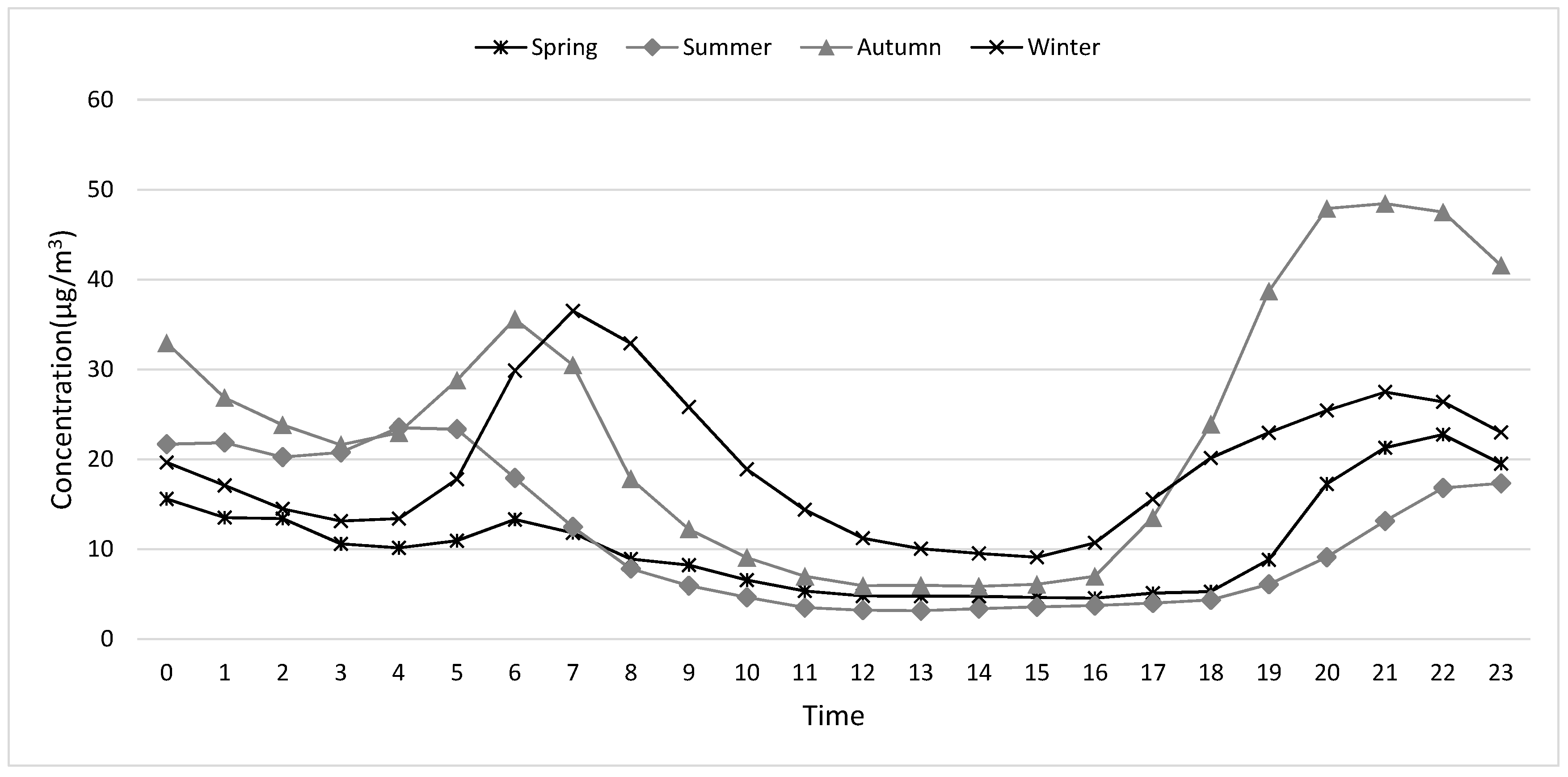
References
- Li, M.; Ren, X.; Yu, Y. Spatial and temporal distribution of PM2.5 pollution in Chinese mainland cities. China Environ. Sci. 2016, 3, 641–650. [Google Scholar]
- Monks, P.S.; Granier, C.; Fuzzi, S. Atmospheric composition change–global and regional air quality. Atmos. Environ. 2009, 43, 5268–5350. [Google Scholar] [CrossRef]
- Young, P.J.; Archibald, A.T.; Bowman, K.W. Pre-industrial to end 21st century projections of tropospheric ozone from the Atmospheric Chemistry and Climate Model Inter comparison Project (ACCMIP). Atmos. Chem. Phys. 2013, 13, 2063–2090. [Google Scholar] [CrossRef]
- Stocker, T.F.; Qin, D.; Plattner, G.K.; Tignor, M.; Allen, S.K.; Boschung, J.; Nauels, A.; Xia, Y.; Bex, V.; Midgley, P.M. IPCC, 2013: Climate Change 2013: The Physical Science Basis. Contribution of Working Group I to the Fifth Assessment Report of the Intergovernmental Panel on Climate Change; Cambridge University Press: Cambridge, UK, 2013. [Google Scholar]
- Brauer, M.; Freedman, G.; Frostad, J. Ambient Air Pollution Exposure Estimation for the Global Burden of Disease 2013. Environ. Sci. Technol. 2015, 50, 79–88. [Google Scholar] [CrossRef]
- Li, T.; Yan, M.; Ma, W. Short-term effects of multiple ozone metrics on daily mortality in a megacity of China. Environ. Sci. Pollut. Res. 2015, 22, 8738–8746. [Google Scholar] [CrossRef] [PubMed]
- Feng, Z.; Hu, E.; Wang, X. Ground-level O3 pollution and its impacts on food crops in China: A review. Environ. Pollut. 2015, 199, 42–48. [Google Scholar] [CrossRef]
- Monks, P.S.; Archibald, A.T.; Colette, A. Tropospheric ozone and its precursors from the urban to the global scale from air quality to short-lived climate forcer. Atmos. Chem. Phys. 2015, 15, 8889–8973. [Google Scholar] [CrossRef]
- Gaudel, A.; Cooper, O.R.; Ancellet, G.; Barret, B.; Boynard, A.; Burrows, J.P.; Clerbaux, C.; Coheur, P.-F.; Cuesta, J.; Cuevas Agulló, E.; et al. Tropospheric Ozone Assessment Report: Present-day distribution and trends of tropospheric ozone relevant to climate and global atmospheric chemistry model evaluation. Elem. Sci. Anthr. 2018, 6, 39. [Google Scholar] [CrossRef]
- Poberaj, C.S.; Staehelin, J.; Brunner, D.; Thouret, V.; Backer, H.D.; Stübi, R. Long-term changes in UT/LS ozone between the late 1970s and the 1990s deduced from the GASP and MOZAIC aircraft programs and from ozonesondes. Atmos. Chem. Phys. 2009, 9, 2435–2499. [Google Scholar] [CrossRef]
- Cheng, L.; Wang, S.; Gong, Z. Ozone Pollution Trend and Spatial-temporal Distribution Characteristics in Beijing-Tianjin-Hebei Region. China Environ. Monit. 2017, 33, 14–21. [Google Scholar]
- Kalabokas, P.D.; Repapis, C.C. A climatological study of rural surface ozone in central Greece. Atmos. Chem. Phys. 2004, 4, 1139–1147. [Google Scholar] [CrossRef]
- Kalabokas, P.D.; Mihalopoulos, N.; Ellul, R.; Kleanthous, S.; Repapis, C.C. An investigation of the meteorological and photochemical factors influencing the background rural and marine surface ozone levels in the Central and Eastern Mediterranean. Atmos. Environ. 2008, 42, 7894–7906. [Google Scholar] [CrossRef]
- Zhang, Y.; Wang, W.; Wu, S.Y. Impacts of updated emission inventories on source apportionment of fine particle and ozone over the southeastern US. Atmos. Environ. 2014, 88, 133–154. [Google Scholar] [CrossRef]
- Reddy, P.J.; Pfister, G.G. Meteorological factors contributing to the interannual variability of midsummer surface ozone in Colorado, Utah, and other western U.S. states. J. Geophys. Res. Atmos. 2016, 121, 2434–2456. [Google Scholar] [CrossRef]
- Otero, N.; Sillmann, J.; Schnell, J.L. Synoptic and meteorological drivers of extreme ozone concentrations over Europe. Environ. Res. Lett. 2016, 11, 024005. [Google Scholar] [CrossRef]
- Fiore, A.M.; Naik, V.; Leibensperger, E.M. Air quality and climate connections. J. Air Waste Manag. Assoc. 2015, 65, 645–685. [Google Scholar] [CrossRef] [PubMed]
- Barnes, E.A.; Fiore, A.M.; Horowitz, L.W. Detection of trends in surface ozone in the presence of climate variability. J. Geophys. Res. Atmos. 2016, 121, 6112–6129. [Google Scholar] [CrossRef]
- Zanis, P.; Hadjinicolaou, P.; Pozzer, A.; Tyrlis, E.; Dafka, S.; Mihalopoulos, N.; Lelieveld, J. Summertime free-tropospheric ozone pool over the eastern Mediterranean/Middle East. Atmos. Chem. Phys. 2014, 14, 115–132. [Google Scholar] [CrossRef]
- Safieddine, S.; Boynard, A.; Hao, N.; Huang, F.; Wang, L.; Ji, D.; Barret, B.; Ghude, S.D.; Coheur, P.F.; Hurtmans, D.; et al. Tropospheric ozone variability during the East Asian summer monsoon as observed by satellite (IASI), aircraft (MOZAIC) and ground stations. Atmos. Chem. Phys. 2016, 16, 10489–10500. [Google Scholar] [CrossRef]
- Simon, H.; Reff, A.; Wells, B. Ozone Trends Across the United States over a Period of Decreasing NOx and VOC Emissions. Environ. Sci. Technol. 2015, 49, 186–195. [Google Scholar] [CrossRef]
- Karlsson, P.E.; Klingberg, J.; Engardt, M. Past, present and future concentrations of ground-level ozone and potential impacts on ecosystems and human health in northern Europe. Sci. Total Environ. 2017, 576, 22–35. [Google Scholar] [CrossRef] [PubMed]
- Shi, C.; Wang, S.; Liu, R. A study of aerosol optical properties during ozone pollution episodes in 2013 over Shanghai, China. Atmos. Res. 2015, 153, 235–249. [Google Scholar] [CrossRef]
- Wang, W.N.; Cheng, T.H.; Gu, X.F. Assessing spatial and temporal patterns of observed ground-level ozone in China. Sci. Rep. 2017, 7, 3651. [Google Scholar] [CrossRef]
- Vingarzan, R. A review of surface ozone background levels and trends. Atmos. Environ. 2004, 38, 3431–3442. [Google Scholar] [CrossRef]
- Wang, T.; Xue, L.; Brimblecombe, P.; Lam, Y.F.; Li, L.; Zhang, L. Ozone pollution in China: A review of concentrations, meteorological influences, chemical precursors, and effects. Sci. Total Environ. 2016, 575, 1582–1596. [Google Scholar] [CrossRef] [PubMed]
- Li, K.; Chen, L.; Ying, F. Meteorological and chemical impacts on ozone formation: A case study in Hangzhou, China. Atmos. Res. 2017, 196, 40–52. [Google Scholar] [CrossRef]
- Kang, H.; Liu, Y.; Li, T. The characteristics of AQI and its relationship with meteorological elements in key cities of Heilongjiang province. J. Nat. Res. 2017, 32, 692–703. [Google Scholar]
- Lin, X.; Wang, D. Spatial and temporal evolution of urban air quality in China and its socio-economic driving forces. J. Geogr. 2016, 71, 1357–1371. [Google Scholar]
- HJ 633-2012, Technical Regulation on Ambient Air Quality Index (on Trial); China Environmental Science Press: Beijing, China, 2012.
- HJ/T193-2005, Monitoring Regulation for Ambient Air Quality; China Environmental Science Press: Beijing, China, 2005.
- HJ 663-2013, Technical Regulation for Ambient Air Quality Assessment (on Trial); China Environmental Science Press: Beijing, China, 2013.
- Hatcher, D.A. Simple formulae for Julian day numbers and calendar dates. R. Astron. Soc. 1984, 25, 53–55. [Google Scholar]
- Division of Climate Season QX/T 152—2012; China Meteorological Administration, Meteorological Publishing House: Beijing, China, 2012.
- Cheng, N.; Chen, Z.; Sun, F. Ground ozone concentrations over Beijing from 2004 to 2015: Variation patterns, indicative precursors and effects of emission-reduction. Environ. Pollut. 2018, 237, 262–274. [Google Scholar] [CrossRef]
- Li, J.; Lu, K.; Lv, W. Fast increasing of surface ozone concentrations in Pearl River Delta characterized by a regional air quality monitoring network during 2006–2011. J. Environ. Sci. 2014, 26, 23–36. [Google Scholar] [CrossRef]
- Tombrou, M.; Bossioli, E.; Kalogiros, J.; Allan, J.D.; Bacak, A.; Biskos, G.; Coe, H.; Dandou, A.; Kouvarakis, G.; Mihalopoulos, N.; et al. Physical and chemical processes of air masses in the Aegean Sea during Etesians: Aegean-GAME airborne campaign. Sci. Total Environ. 2015, 506, 201–216. [Google Scholar] [CrossRef]
- Lin, W.; Lin, W.; Xu, X.; Sun, J. Effects of background concentration of reactive gas and long distance transport in Jinsha atmospheric background station. SCIENTIA SINICA Terrae 2011, 41, 573–582. [Google Scholar]
- Fernández-Fernández, M.I.; Gallego, M.C.; García, J.A. A study of surface ozone variability over the Iberian Peninsula during the last fifty years. Atmos. Environ. 2011, 45, 1946–1959. [Google Scholar] [CrossRef]
- Jia, L.N. Changchun Almanac; Jilin People’s Publishing House, Changchun Local Chronicles Compilation Committee: Changchun, China, 2018; pp. 12–20. [Google Scholar]
- Qi, B.; Niu, Y.; Du, R. Analysis of variation characteristics of near-surface ozone concentration in Hangzhou. China Environ. Sci. 2017, 37, 443–451. [Google Scholar]
- Fujita, E.M.; Stockwell, W.R.; Campbell, D.E.; Chinkin, L.R.; Main, H.H.; Roberts, P.T. Weekend/Weekday Ozone Observations in the South Coast Air Basin: Retrospective Analysis of Ambient and Emissions Data and Refinement of Hypotheses. Volume I—Executive Summary. Final Report Prepared for the National Renewable Energy Laboratory, Golden, CO, USA and Coordinating Research Council, Alpharetta, GA, USA. Available online: https://www.researchgate.net/publication/242179822_WEEKENDWEEKDAY_OZONE_OBSERVATIONS_IN_THE_SOUTH_COAST_AIR_BASIN_VOLUME_I_-_EXECUTIVE_SUMMARY (accessed on 12 June 2002).
- Kalabokas, P.D.; Thouret, V.; Cammas, J.P.; Volz-Thomas, A.; Boulanger, D.; Repapis, C.C. The geographical distribution of meteorological parameters associated with high and low summer ozone levels in the lower troposphere and the boundary layer over the Eastern Mediterranean (Cairo case). Tellus B Chem. Phys. Meteorol. 2015, 67, 27853. [Google Scholar] [CrossRef]
- Camalier, L.; Cox, W.; Dolwick, P. The effects of meteorology on ozone in urban areas and their use in assessing ozone trends. Atmos. Environ. 2007, 41, 7127–7137. [Google Scholar] [CrossRef]
- Jacob, D.J.; Winner, D.A. Effect of climate change on air quality. Atmos. Environ. 2009, 43, 51–63. [Google Scholar] [CrossRef]
- Impact of Meteorological Factors on Ozone Pollution in Hong Kong. Available online: http://kns.cnki.net/kcms/detail/11.1895.X.20180822.1711.006.html (accessed on 22 August 2018).
- Characteristics of near Surface O3 Concentration in Harbin. Available online: http://kns.cnki.net/kcms/detail/11.1843.X.20180625.1540.001.html (accessed on 25 June 2018).
- Zhao, X.; Dong, H.; Ji, M. Analysis on the spatial-temporal distribution Characteristics of O3. J. Environ. Sci. 2018, 38, 649–660. [Google Scholar]
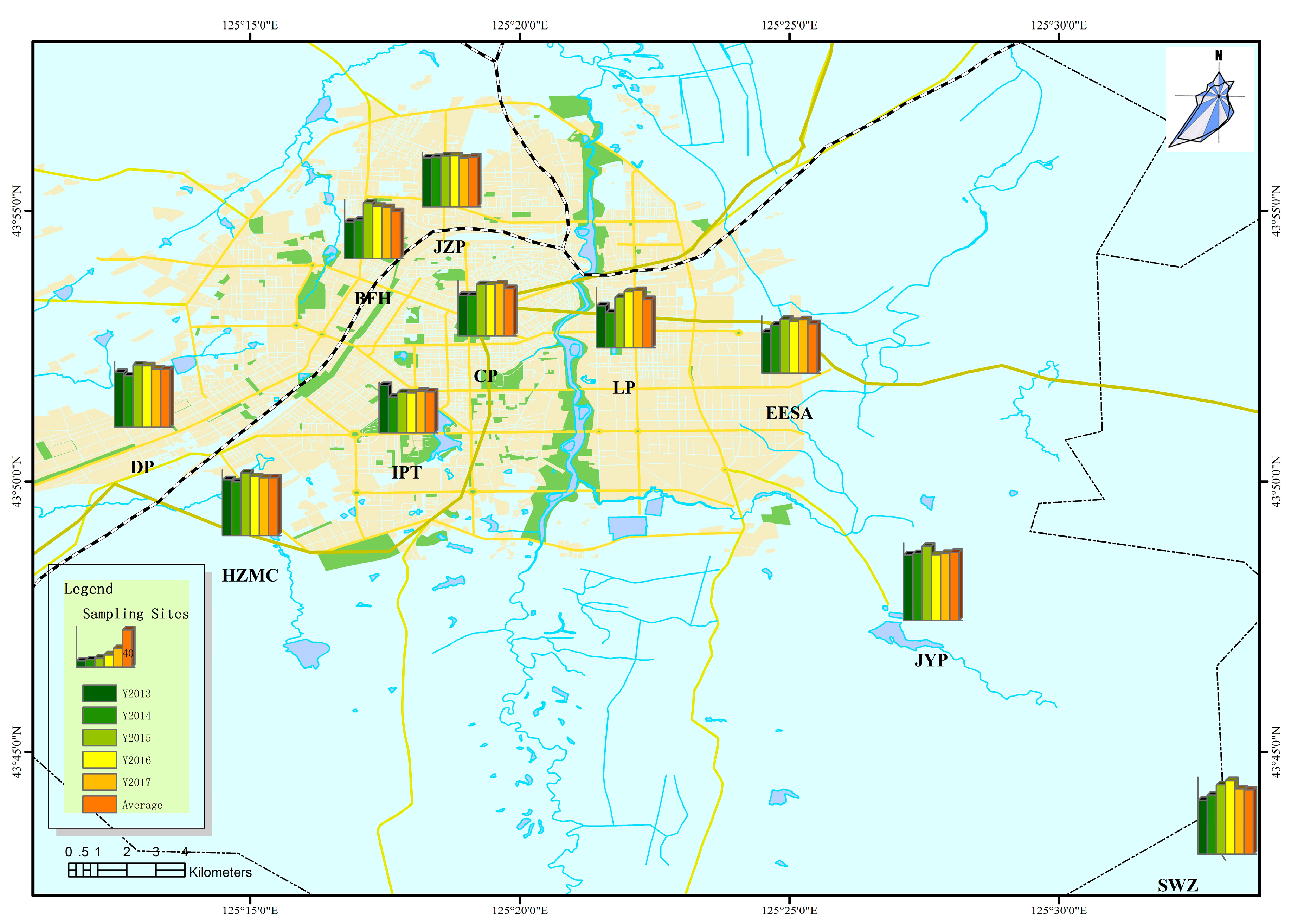
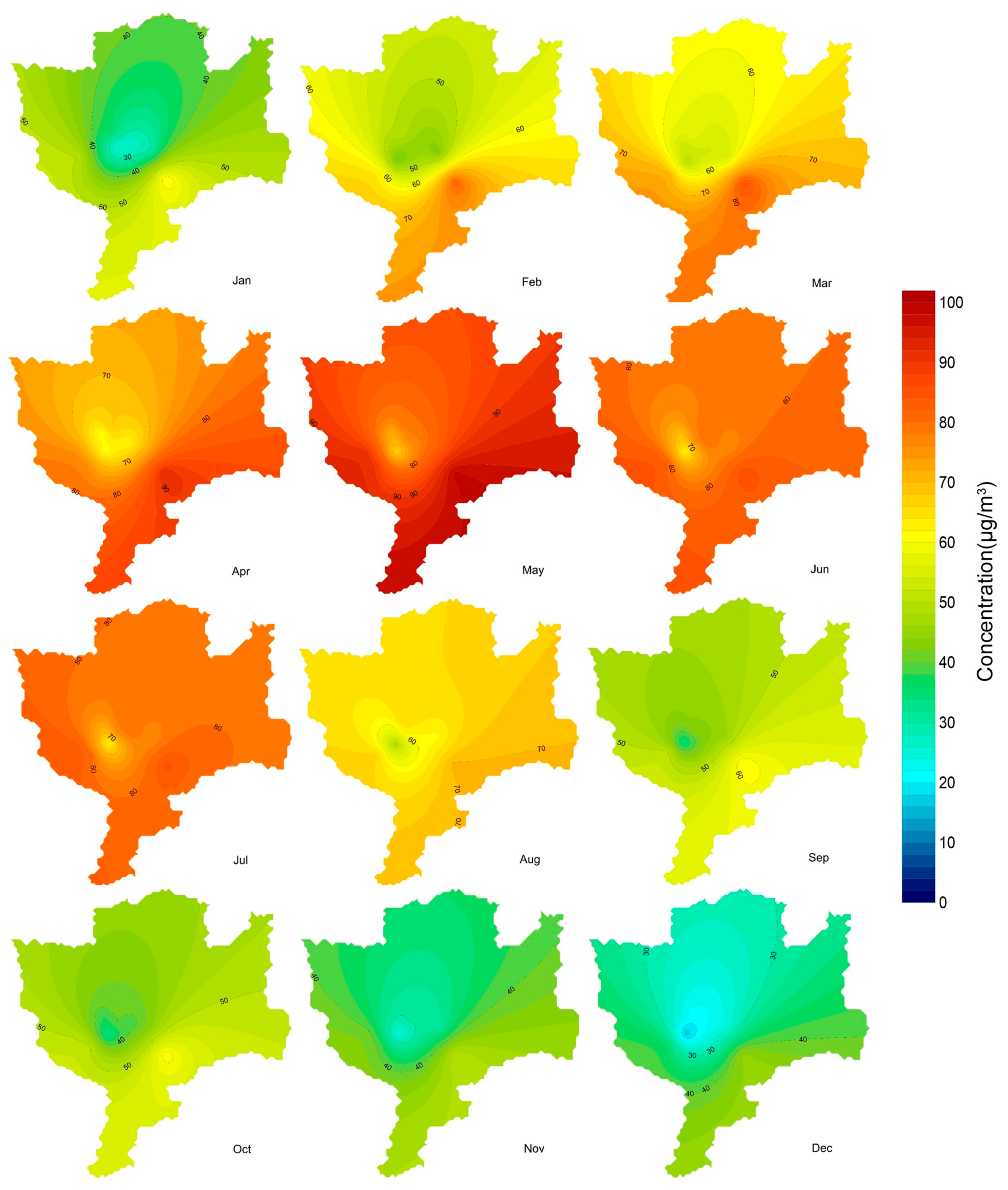
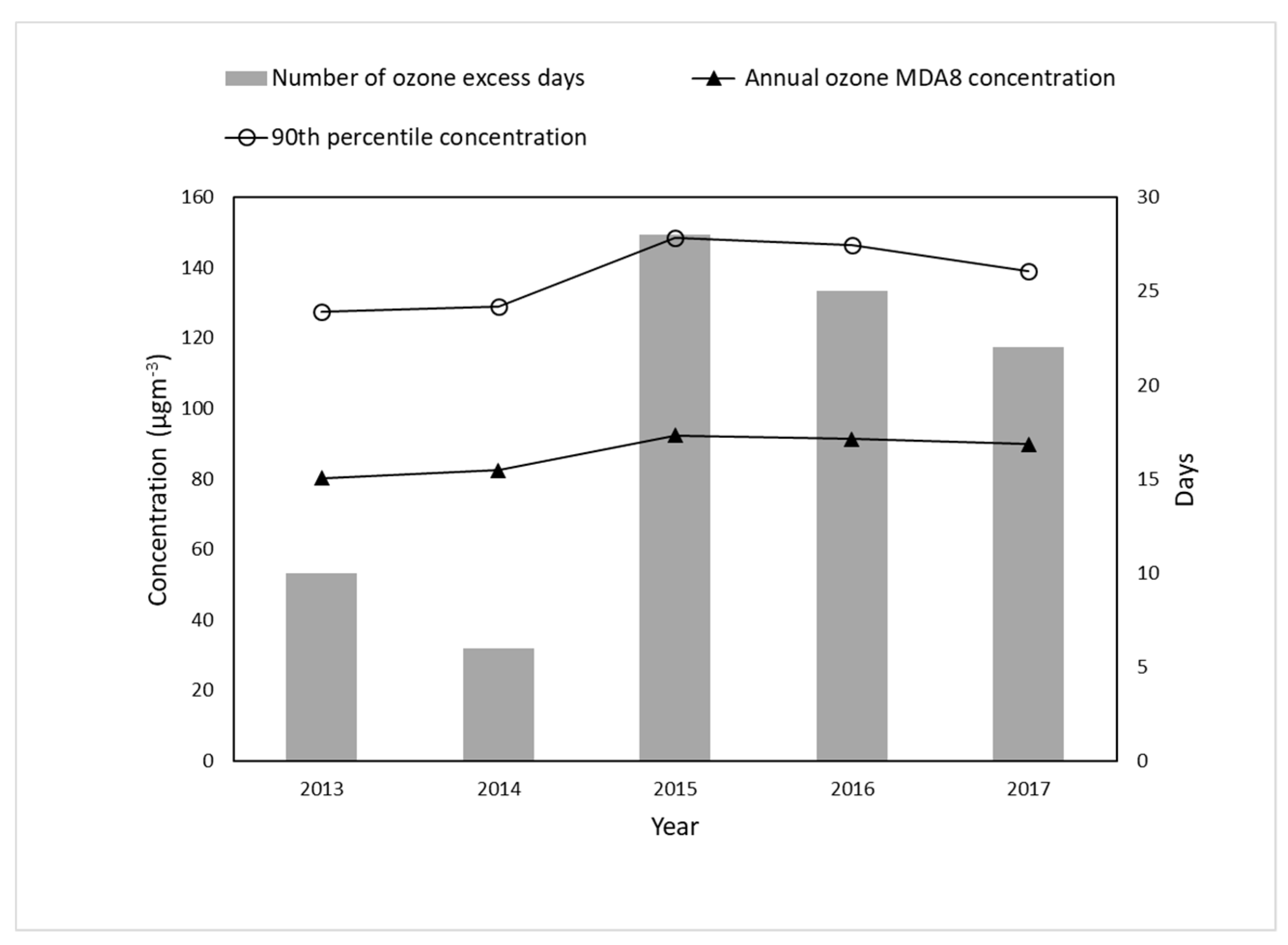
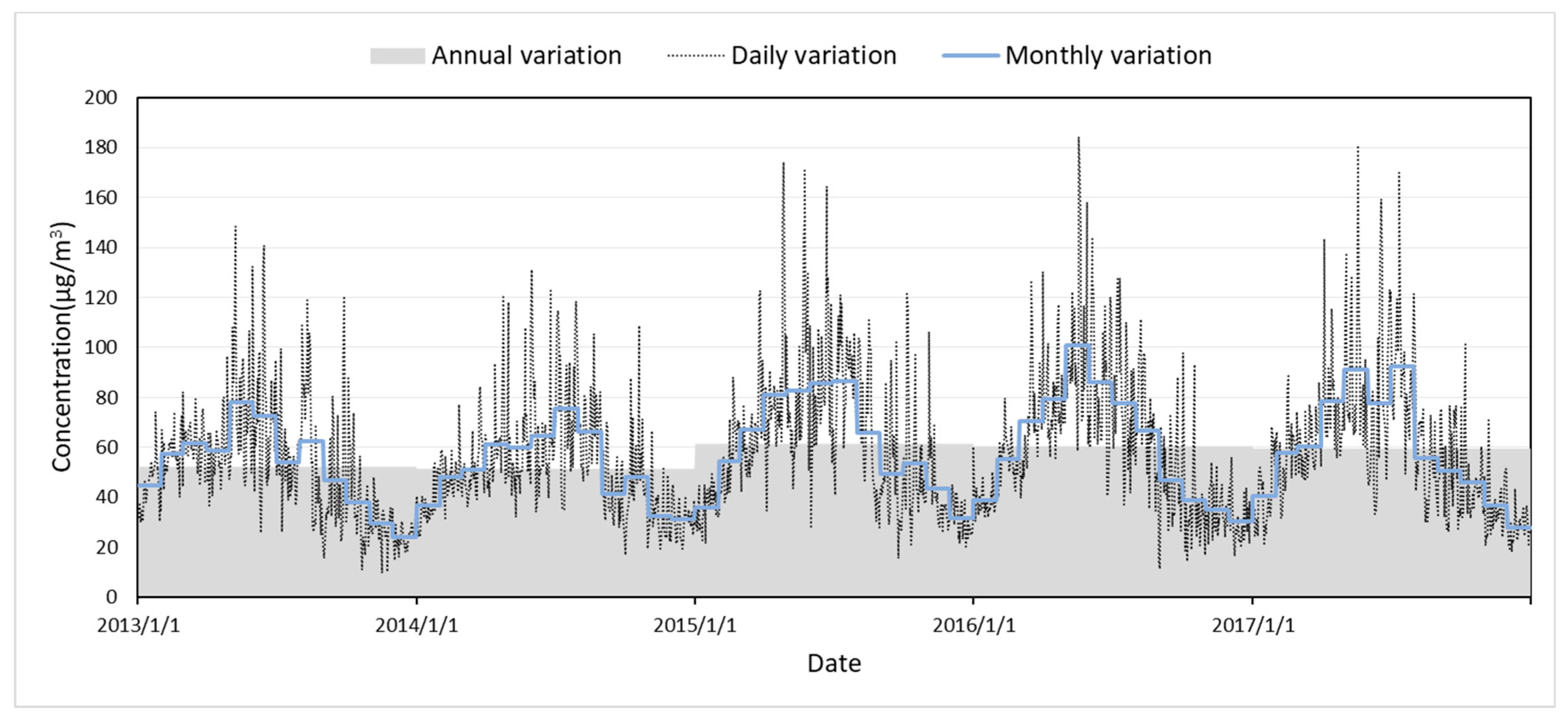
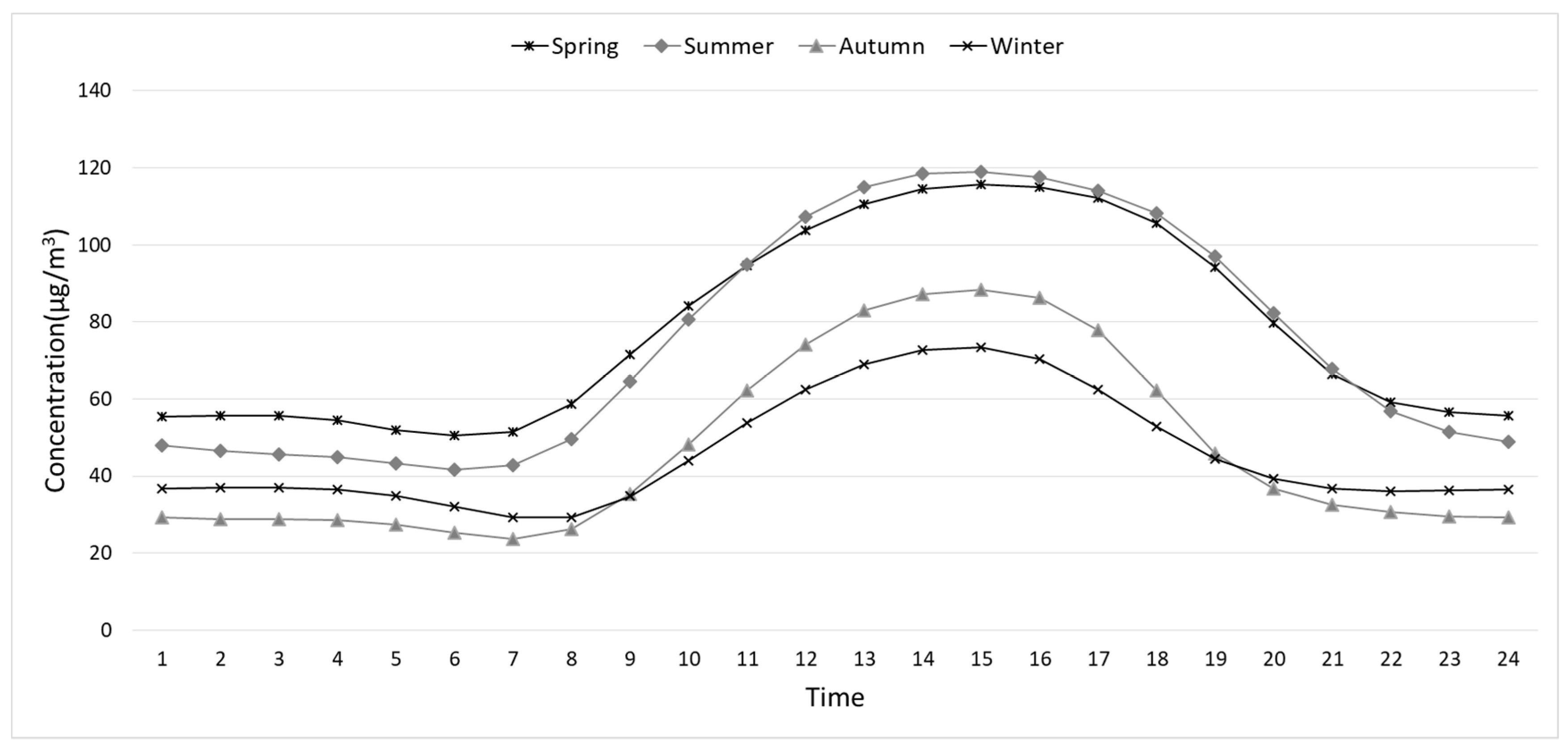
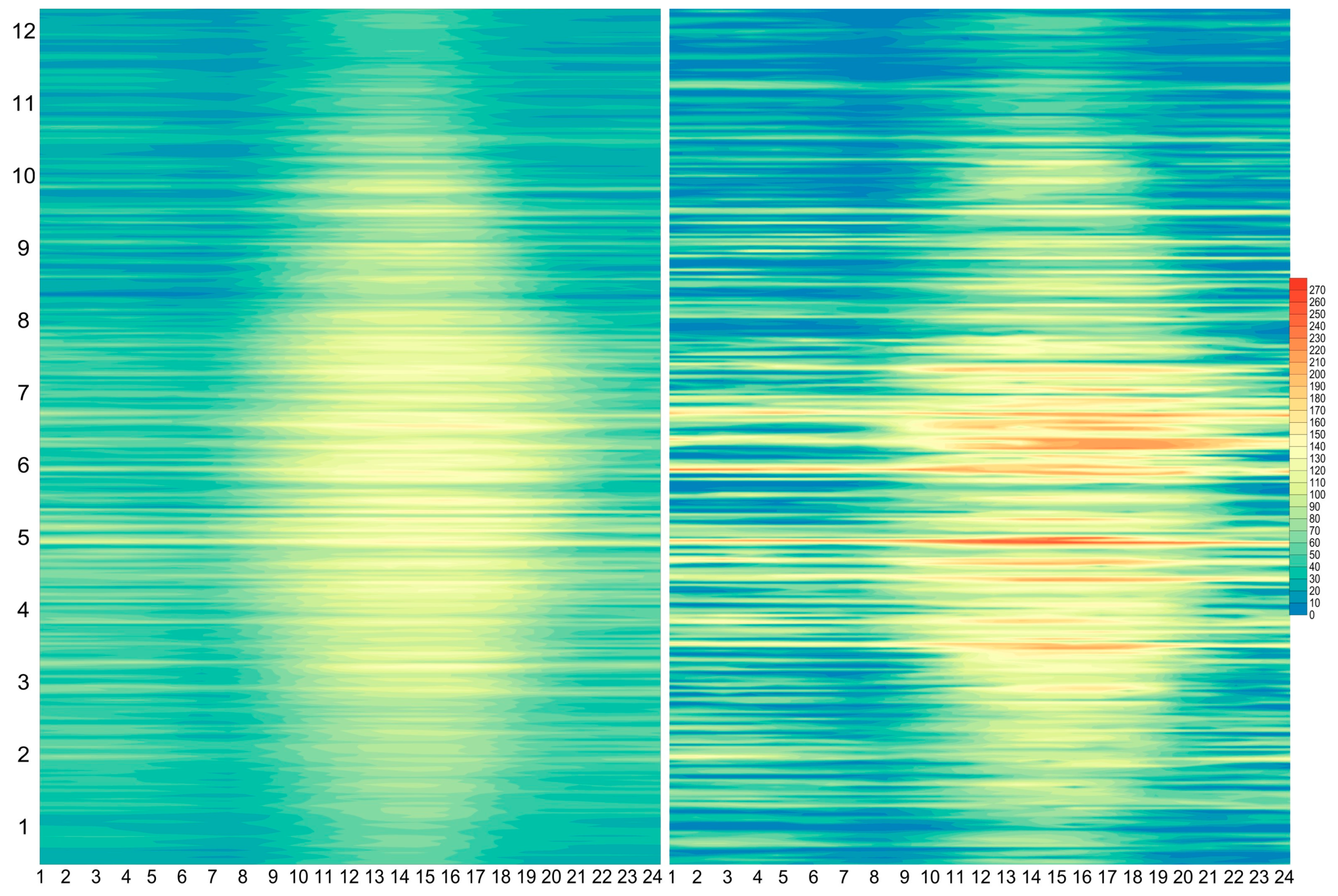
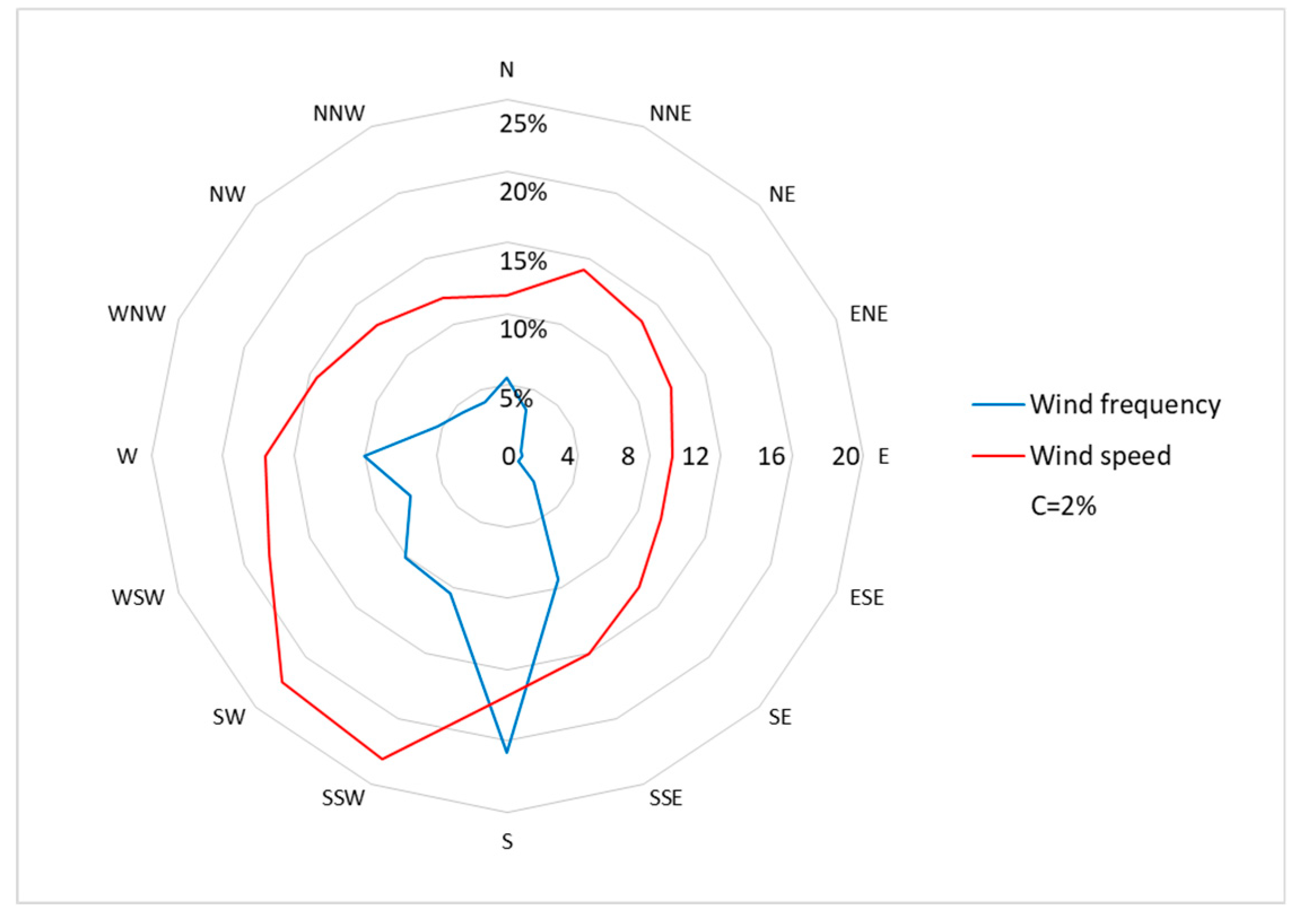
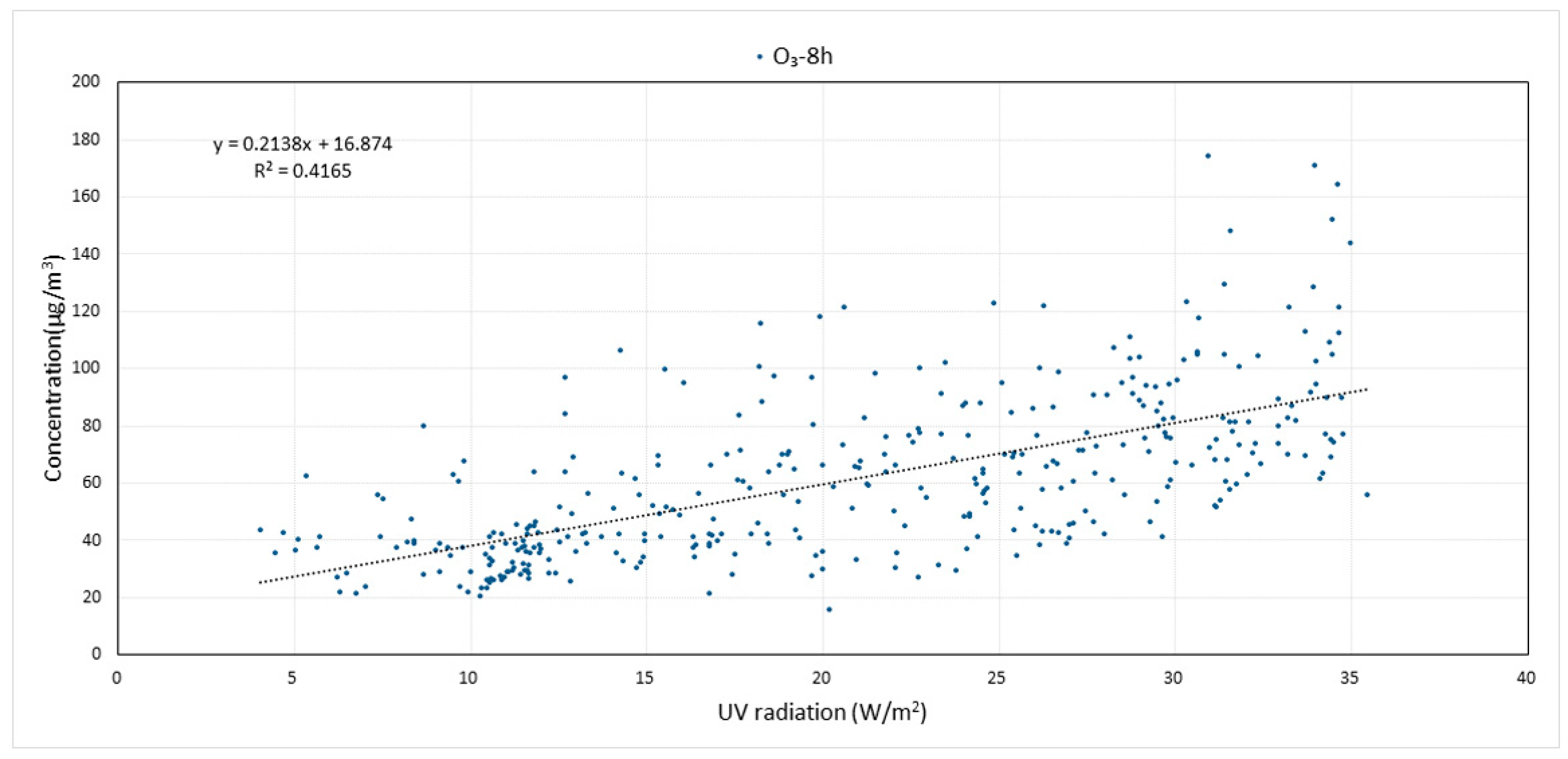
| Name | Environmental Air Quality Functional Area | Major Source of Pollution (Area) | Wind Direction |
|---|---|---|---|
| CP | II | Urban and rural | Upwind |
| BFH | II | Industrial discharge | Upwind |
| IPT | II | Densely populated | Upwind |
| LP | II | Densely populated | Downwind |
| HZMC | II | Urban and rural | Upwind |
| DP | II | Industrial discharge | Upwind |
| JYP | I | Natural reserve | Side wind |
| EESA | II | Densely populated | Downwind |
| JZP | II | Vehicle emission | Downwind |
| SWZ | I | Background | Side wind |

© 2019 by the authors. Licensee MDPI, Basel, Switzerland. This article is an open access article distributed under the terms and conditions of the Creative Commons Attribution (CC BY) license (http://creativecommons.org/licenses/by/4.0/).
Share and Cite
Fang, C.; Wang, L.; Wang, J. Analysis of the Spatial–Temporal Variation of the Surface Ozone Concentration and Its Associated Meteorological Factors in Changchun. Environments 2019, 6, 46. https://doi.org/10.3390/environments6040046
Fang C, Wang L, Wang J. Analysis of the Spatial–Temporal Variation of the Surface Ozone Concentration and Its Associated Meteorological Factors in Changchun. Environments. 2019; 6(4):46. https://doi.org/10.3390/environments6040046
Chicago/Turabian StyleFang, Chunsheng, Liyuan Wang, and Ju Wang. 2019. "Analysis of the Spatial–Temporal Variation of the Surface Ozone Concentration and Its Associated Meteorological Factors in Changchun" Environments 6, no. 4: 46. https://doi.org/10.3390/environments6040046
APA StyleFang, C., Wang, L., & Wang, J. (2019). Analysis of the Spatial–Temporal Variation of the Surface Ozone Concentration and Its Associated Meteorological Factors in Changchun. Environments, 6(4), 46. https://doi.org/10.3390/environments6040046





